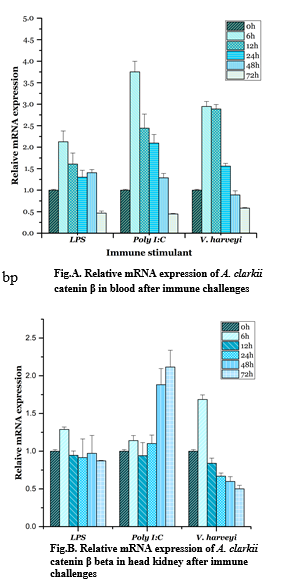EXPRESSION ANALYSIS OF THE IMMUNOMODULATORY GENE, CATENIN ß UNDER MICROBIAL CHALLENGES IN Amphiprion clarkii
Catenin beta or β catenin is a protein involved in important cellular functions such as regulation and coordination of cellular adhesions and gene transcription. It is a major protein function in the Wnt/ β catenin signaling pathway which plays a critical role in immune cell function. The current study has focused on identifying a particular sequence of β catenin from a transcriptomic database of Amphiprion clarkii analyzing its expression pattern in normal physiological conditions and under different immune challenges, to identify its participation in immune cell functions and modulating a particular immune response.
The sequence of A. clarkii was identified from the cDNA library followed by the in- silico analysis of the protein using appropriate bioinformatics tools and software. cDNA samples synthesized from twelve different tissues were subjected to quantitative real-time PCR in determining the tissue-specific expression of the gene. cDNA was synthesized from RNA purified from selected tissues at certain time points after challenging the fish with lipopolysaccharide (LPS), poly I:C, Vibrio harveyi and Phosphate buffered saline (PBS/control) and subjected to quantitative real-time PCR to determine the gene expression patterns under the microbial challenges.
The complete ORF of A. clarkii catenin β consists of 2307 bp encoding 768 amino acids. The highest expression of the gene could be observed in the head kidney followed by blood tissue of fish, see-through the upregulated expression of the gene in important immune organs of fish and thereby reveals its relativity in immune responses. According to the immune challenge data, stimulating fish with all the three immune challenges have upregulated catenin β expression in both the tested tissues. The viral analog Poly I:C has even a significant upregulation of the gene expression compared to other stimulants in early hours in both the tissues. These results may suggest the involvement of catenin β in the antiviral activity of the fish immune system, which will be validated further by other specific in-vitro antiviral assays.
